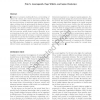Free Online Productivity Tools
i2Speak
i2Symbol
i2OCR
iTex2Img
iWeb2Print
iWeb2Shot
i2Type
iPdf2Split
iPdf2Merge
i2Bopomofo
i2Arabic
i2Style
i2Image
i2PDF
iLatex2Rtf
Sci2ools
112
click to vote
JOCN
2010
2010
The Neural Basis for Spatial Relations
Studies in semantics traditionally focus on knowledge of objects. By contrast, less is known about how objects relate to each other. In an fMRI study, we tested the hypothesis that the neural processing of categorical spatial relations between objects is distinct from the processing of the identity of objects. Attending to the categorical spatial relations compared with attending to the identity of objects resulted in greater activity in superior and inferior parietal cortices (especially on the left) and posterior middle frontal cortices bilaterally. In an accompanying lesion study, we tested the hypothesis that comparable areas would be necessary to represent categorical spatial relations and that the hemispheres differ in their biases to process categorical or coordinate spatial relations. Voxelbased lesion symptom mapping results were consistent with the fMRI observations. Damage to a network comprising left inferior frontal, supramarginal, and angular gyri resulted in behavioral ...
Related Content
| Added | 19 May 2011 |
| Updated | 19 May 2011 |
| Type | Journal |
| Year | 2010 |
| Where | JOCN |
| Authors | Prin X. Amorapanth, Page Widick, Anjan Chatterjee |
Comments (0)

